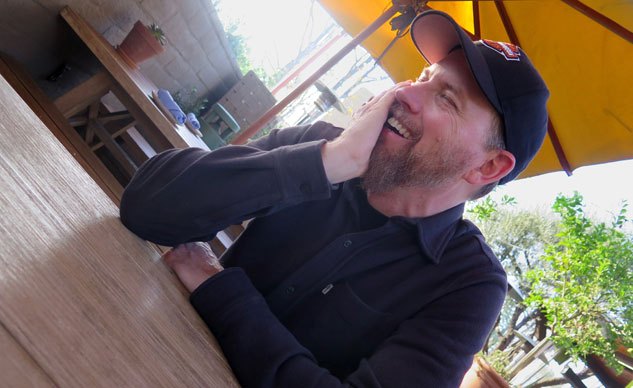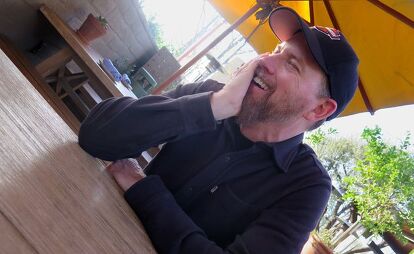MO Interview: Brad Richards, Design Director, Harley-Davidson
Can it get any more American Iconic than Ford trucks and Harley-Davidsons?
You really can’t keep it any more real than Harley’s new Design Director, Brad Richards, who honed his American iron (and aluminum) chops at Ford Trucks before making the move from Detroit to Milwaukee a year ago. We got the chance to sit down with him and ask a few questions last week when he was in town to show off Harley’s new Low Rider S.
2016 Harley-Davidson Low Rider S First Ride Review
MO: I have to think that if you’re a motorcycle designer, one of the hardest places to be one would be Harley-Davidson.
Brad Richards: Why would you think that?
JB: I’d think there’s a long list of things you’re not allowed to mess with – the shape of the gas tank, the way the gas tank settles over the engine, the angle of the Dyna’s shocks. The rear fender on your new Low Rider S looks like the rear fender of the Harley I borrowed to ride to Sturgis when Harley was celebrating its 90th anniversary, which I think was 1993.
BR: Yep. That fender is probably from the same tooling. You bring up a really good point, but the trick is if we evolve it in the right way, all those parts you talk about, you don’t notice the evolution. A lot of those parts are significantly different from the parts they appear to look just like.
The real challenge with my job is that I have to keep one foot in the past, and one foot looking out into the future – and it’s finding the right balance of heritage and pushing the line enough that our customers love it while the product remains relevant. It’s a huge challenge. But it’ a very exciting place to work, especially if you have a passion for the brand like I do.
JB: What was your first bike as a kid?
BR: I had a BMW, I was in a band. We rented a space in downtown Detroit where I grew up and we were terrible. But we were just kids. In a corner of the space was a welding room, and there was a handlebar sticking out of this old pile of junk. I slowly dug it out over a period of a couple of weeks. It turned out to be a 1950 R50, classic Boxer, Earles fork. My friend said I could have it if I’d get it out of there, so I took it home and over the course of about five years, restored it. That was my first streetbike. I rode dirtbikes and things.
JB: You grew up in Detroit?
BR: Born and raised two blocks from the Ford Motor Company, where I spent 18 years working. I tell people in 40 years I went two blocks! I worked at Ford Truck, and it was very similar to Harley-Davidson in the fact that you had to evolve the DNA at a pace that customers would appreciate, you couldn’t just leave what they know and love behind. But you had to also push it forward into the future.
JB: Ford Trucks?
BR: I was part of the F-150 team, also F-250, Raptor…
JB: That’s America’s best-selling vehicle for like 100 years. Conestoga wagon, then F-150, right?
BR: Yep. So to go to Harley-Davidson from there I feel very blessed.
JB: How did that jump take place?
BR: I was at Ford 18 years and was in the Truck Dept, when Harley established the Ford bond with the Harley-Davidson trucks.
JB: Ohhhhh yeah…
BR: Remember those? So they needed somebody who understood the Harley-Davidson brand to kind of manage that. So they asked me to do it, which was really cool. And that’s how I met Willie (G. Davidson) and Louie (Netz) and the team, and over the course of however long it was – 10 years – a lot of visits. Harley-Davidson came to Dearborn quite a bit. We’d travel to Sturgis, we’d ride to Sturgis or Daytona, and hang out with Willie and the team and talk about what we were gonna do next year with the truck, because the truck changed every year. So we’d go on rides with the (Harley) design team, and that was definitely my intro to getting to know those guys.
JB: I guess the classic designer question is, what other things influence your design choices at Harley? To me, it seems like Harley isn’t really influenced by anything except that “classic American motorcycle,” which to me is a Harley? It’s kind of its own loop.
BR: Uh, yeah. What I love about Harley-Davidson, and in fact when I left Ford Motor Company a lot of my friends were scratching their heads, but I said, y’know, if you think about Harley-Davidson – and I was a Harley-Davidson guy – I’ve got about nine of them, and I like the old stuff from the ’30s all the way up. I’ve got a Flathead, a Knucklehead, I’ve got three Panheads. I raced at Bonneville on a Panhead… so, I love the brand. It reminds me, the motorcycle, there’s something in it, something innate in its DNA that reminds me of growing up in the Midwest, and companies like Ford Motor Company, the fact that it’s from Milwaukee and was made by people who didn’t live too far from where I grew up. It kind of connects me to the product. These motorcycles are very near and dear to me.
So I’d say to my friends, I’ve got Ford on my resume and now Harley. To me, the only things left are Coca-Cola and Levi’s, these great American brands. Being a Harley-Davidson enthusiast and a rider, yeah, I love it. So what influences me? I’m really into performance and racing, I like that side of Harley-Davidson, the racing history. I also like the fact that the bikes evolve at a pace where I can look at a Heritage or a Deluxe and still see a 1936 Knucklehead or a VL.
JB: Are you trying to press for more high performance? Is the VR1000 going to happen again?
BR: Well I don’t think the VR1000 is going to happen again. There’s nothing official, but there is a core group within the company that’s viciously passionate about racing. I can’t say anything or confirm anything, but I would think that racing and Harley-Davidson will forever be side by side, in some shape or form in the future.
Back to design, though, in the car industry, everything we did was about covering up the mechanics, doing a body, doing a shape. With a motorcycle, you’re designing anatomy, which is really a challenge because you really have to pay attention to nuts and bolts and where the cables go, which all becomes part of the design DNA as well. Harley-Davidson’s done a great job over the years making sure the motor’s the first thing you notice.
JB: Can you point to any part of the Low Rider S that you’re proud of, that you’d be able to point out to your kids someday and say ‘that’s mine’?
BR: That’s one of the more unfortunate things about being Director of Design, I don’t really pen the bikes myself, we have a team of guys back in Milwaukee who are really talented, and those guys do the work. They’re ingrained in the culture, they see what’s going on, and they pull a bike together. Dais Nagao designed the Low Rider S, but it was one of the first ones we did since I came on board just over a year ago. I do feel akin to the bike, in fact I bought one – the first new Harley I’ve bought since 2003.
I like the fact it’s a no-nonsense performance-based machine, not a flashy look-at-me boulevard cruiser. It sends a powerful message: big motor, big brakes, good suspension. It’s a great bike, handles fantastically – really connected to the road – so I’m pretty proud of that.
JB: Did you pay full pop? Do you get the deal?
BR: We get 20% off. I think I did okay, I hear they’re selling really well…
JB: You just got here then?
BR: Yeah, it’s been quick, I’ve been here about a year and a month. I was working for Ford in Germany when I got the call. It was a big change from working on tiny German cars to Harley-Davidsons… but I’ll tell you what, where I lived, in Cologne – Germany and Milwaukee are not 1000 miles apart.
JB: There’s beer in both places. German Ford trucks?
BR: No, I was in Ford trucks for 17.5 years, then I’d just accepted a position as Chief Designer at the Cologne studio doing small cars for Ford. Went over for one month when I got the call. I loved Ford Motor Company, still love it, still have good friends there, and the relationship between Harley-Davidson and Ford is pretty interesting: Both companies were founded in 1903. The design teams, we know each other. It’s not so open we visit each other’s studios, but we’re good friends. The companies are very similar, both strong legacies, strong foundations in the past. Also, the need to innovate. The last F-150 was an interesting challenge: You’re doing an aluminum truck. The customer changed quite a bit. They no longer wanted to be seen as cowboys. It was about making them seem relevant. They wanted to be relevant, to have the technology in the truck that automobiles have. No customer demographic is stagnant, they’re constantly evolving – and that’s the same way I approach Harley-Davidson. Our core customers, especially, as we start moving some of these projects forward.
JB: What big changes do you plan to implement, now that you’ve made it through the probationary period?
BR: Yeah I made it! Well, again, it’s how do you evolve the motorcycles at the right pace. There’s a very good plan in place and I really can’t talk about it. But I’m excited about the future.
JB: You can talk about it a little.
BR: For me, CVO is something I really want to focus on. We’ve had our Custom Vehicle Operations formula that’s been pretty successful over the years – big motor, great wheels, expensive paint. I’m really looking forward to evolving that product. Then, I feel like if I do the core bikes really well like the Low Rider S… I don’t wanna say nostalgia or heritage, but it’s based on an FXR, that’s the kind of performance base we’re going after. If we can do those bikes really well, and the Heritage Softails, and the FL touring bikes really well… do all that product the right way, make it look contemporary, then the customer will give us permission to really push the boundaries. Livewire for instance. So I’m really excited for the future, some of the new bikes we’re talking about doing. I think in five years it won’t be, or it won’t be even less, your father’s Harley-Davidson Motor Company. There’s some fun stuff coming.
More by John Burns







































Comments
Join the conversation
Dear Brad, Would it be possible for Harley Davidson to produce an American made Sport Touring bike? Something like a Concours 14, FJR, Norge, Trophy, or BMW RT? Maybe a nice tall seat, some back and down pegs, an engine out of the "other" Harley (the one that no one buys because it is water cooled)? Full fairing, under 600 lbs., etc. Thank You, Dale
Dear Brad! I've been e-mailing Harley and Jon Olefsen to duplicate a spoke wheel look for a cast wheel.Getting closer with the new Roadster wheel as quoted in HOG magazine-" inspired by classic laced wheels" awesome.Now the clincher! Add protruding steel brushing lines from the centers of the black castings further suggesting spokes! Thanks Harley!